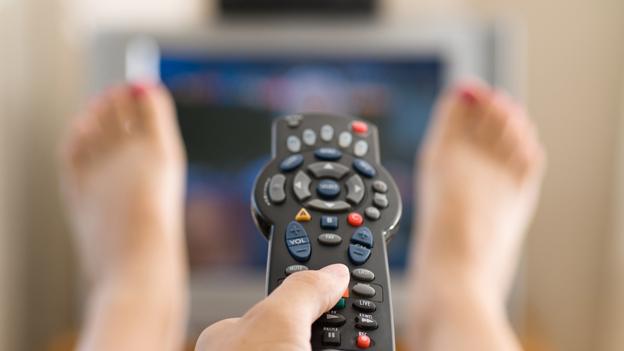EE - is the couch potato cooked?
- Published
- comments

"Britain needs a whole new way of watching television, and EE is the firm that will drag the TV industry kicking and screaming into the mobile era."
That's the message at the launch of the mobile operator's new service EE TV, which claims to be "the UK's most advanced TV service." Now it's evident that EE needs to be in TV, but its belief that viewers are impatient for a different television experience is open to question.
Firstly, it's entering a market which is not at all short of choice. Roughly 60% of households now subscribe to some kind of pay-TV service from the likes of BskyB, Virgin Media and BT Vision. But even in these households, EE's chief executive Olaf Swantee told us, they spend 80% of their time watching free-to-air TV.
The rest of the population - what you might call the Freeview homes - now also have access to all sorts of gadgets and gizmos from Google Chromecast to Roku to give them access to online television. These people, along with those growing weary of paying a lot for subscription TV, are the targets for EETV.
In the presentation at the mobile operator's headquarters there is plenty of talk of "millennials" and their viewing habits as the template for the new service. These are apparently people who grew up with the internet and now get most of their TV from YouTube, viewing on phones and tablets .
"Long nights in front of one screen are ending," Olaf Swantee tells us."Simply put, the couch potato is cooked." The remote control is also not long for this world, with people wanting to use a phone or tablet to switch channels or find an on demand programme to watch.
So his answer is a new service which allows you to switch seamlessly between tablet phone and TV, to catch up with anything that's been broadcast within the past 24 hours, even to "flick" programmes from your tablet onto the big television. But what it does not have is any programming you can't get elsewhere - indeed they don't even have services like Netflix yet.
When I ask Mr Swantee what potential customers are getting if there isn't any unique content, his answer is "a user interface that stands out." Somehow I doubt that viewers across the land are going to be wowed by that promise.
Technology firms, from Microsoft to Google to Apple, have all been trying to change the way we use television for a decade or more. But the viewers have been stubbornly resistant to change. Ofcom's figures do show a slight decline in TV consumption but the average UK adult still watches nearly 4 hours of broadcast television a day, and on-demand and recorded programmes still form quite a small portion of their viewing.
It is certainly true that younger viewers' habits are changing rapidly, but for much of the population television is still about turning on, leaning back and often dozing off. And it's those older viewers who must be EE's target audience because they pay the household broadband and TV bills.
That is where the new player could prosper because its service will look very affordable to anyone paying BT and Sky for a combined TV and broadband package. And that is the real logic behind EE's move. Mobile firms have watched anxiously as BT offered a cheap TV deal to keep its broadband customers on board while Sky kept its TV subscribers happy with bargain broadband.
Now they too want to offer what the industry inelegantly describes as "fourplay" - TV, broadband, fixed and mobile phones. Households are looking for a cheap and easy way to get all of those services on one bill. That - rather than the delights of a new user interface - could get viewers switching on to EETV.